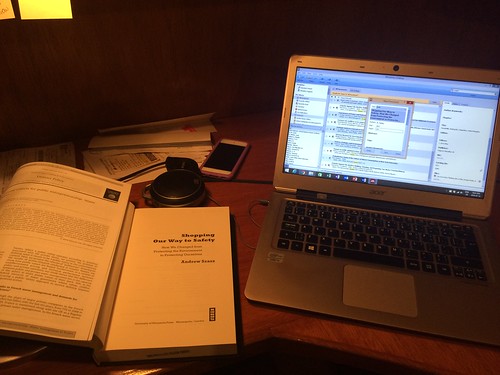While I have a couple of blog posts pending (both by request, on how to prepare for comprehensive exams and how to build a research trajectory and a project pipeline for early career scholars), I wanted to write a post on something that I get asked about quite frequently. I arrived to the daily writing routine quite naturally, because I love stationery and more generally, I adore writing. But I always get asked “how do I build a good writing routine?”
As someone who studies institutional theory, I am well aware of the role of habits and routines in creating structures that govern agents’ actions. Repetition creates routines, routines create norms, norms lead to building rules and rules create institutions. So, the basis of governing individual actions resides in repeating a specific routine. I read somewhere that it only takes 21 days to build a habit (though read here, here and here to bust that myth). Whenever I fall out of a routine, it does take me about 3 weeks to regain regularity. Your mileage may vary, of course.
Ok, #AcademicTwitter it's Friday "respond-only-with-a-GIF" time! My next blog post should be on: (vote, RT and respond)
— Dr Raul Pacheco-Vega (@raulpacheco) July 29, 2017
I figured I would offer four strategies to help you build an academic routine. Three come from scholars I respect a lot and who write about academic writing. The fourth (forgive the self-citation) comes from me 🙂
1. Follow a deadline-based calendar (Wendy Belcher)
The first strategy I would recommend anyone who is trying to build an academic routine is to follow the 12 weeks model that Dr. Wendy Belcher suggests in her book. Having a calendar and a set of firm deadlines for when you’re going to get stuff done may help motivate you to write. Deadlines have a very strong power over me!
2. Use a repertoire of daily writing techniques (Tanya Golash-Boza)
In this post, Dr. Tanya Golash-Boza offers a number of strategies you can use to write every day, from line-editing text you already have produced to drafting new text on a blank page. As Tanya suggests, you can build a daily writing routine by following at least two different kinds of writing strategies a day.
3. Follow a daily prompt, 5 days a week (Raul Pacheco-Vega)
In this post, I suggested five different prompts you could use to “trigger” writing. To build your own academic writing practice, you could test each one of the prompts, one every day. So, for example, on Mondays (when I’m usually very alert), I don’t need a prompt, but I can use one (an unfinished piece of writing from the previous week). On Thursdays I’m usually tired, so I’ll use a table or a dataset to prompt me to write.
4. Use a time-based incentive approach: the 15 minute challenge (Jo Van Every)
One of the things that I’ve heard from a lot of people is “I don’t have the time to write!” Well, I would definitely believe you if I didn’t have the same problem as everyone does: I, too, have to commute, travel by bus, sit at my doctor’s office waiting until he/she comes out and look for me. So, Dr. Jo Van Every has encouraged people to try writing 15 minutes a day, at least. Trust me (and her!) – 15 minutes IS A LOT MORE than zero minutes. So, Jo suggests that you should try the 15 Minute #AcWri Challenge. I can assure you, building up to 2 hours every day (as I do) is much easier if you start in increments of 15 minutes. So I would encourage you to take Jo’s challenge and see how many sets of 15 minutes you can do a day. This should be done incrementally, in my view.
In the end, I believe the only way to build an academic writing routine is to create a set of habits that will enable you to derive a reward from writing. For me, the best reward is seeing paragraphs filled, pages completed, etc.





0 Responses
Stay in touch with the conversation, subscribe to the RSS feed for comments on this post.